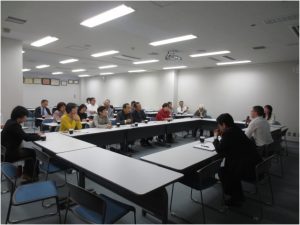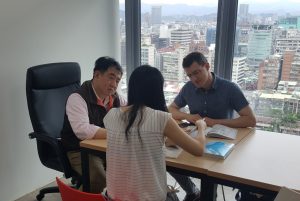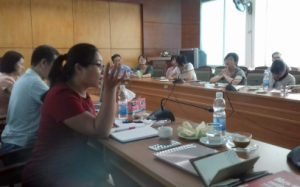![]()
In this case study
Who used the Traction framework?
Where were the cities in their adaptation journey?
What were the key stages of the Traction process – what happened?
What was the learning from applying the Traction framework?
Who could we learn from how the Traction framework has been used in East- and South-East Asia?
Using Traction in East- and South East Asia – retrospective review of adaptation action
Who used the Traction framework?
The Traction framework was used as a starting point for a retrospective evaluation of competences for climate change adaptation actions across subtropical cities in east- and south-east Asia, with a particular focus on strategies involving urban greenspace and nature-based solutions. This additional evaluation and deployment of the Traction framework at local government level was used to guide the analysis process for academic research projects funded by the Wellcome Trust and by the Scottish Funding Council/Global Challenges Research Fund into climate adaptation in east- and south-east Asia.
Where were the cities in their adaptation journey?
The case study local governments evaluated were Fukuoka City Government (Japan); Taipei City Government (Taiwan); and Hanoi People’s Committee (Vietnam). Taipei already had a city-wide adaptation plan in place at the time the research was undertaken, Fukuoka had an adaptation plan embedded within a broader climate change plan, and Hanoi had legislation in place to promote adaptation actions within a wider range of climate change countermeasures.
What were the key stages of the Traction process – what happened?
Enablers of adaptation action in the three cities were assessed through research, which involved desk review of existing policy documents and in-depth interviews with stakeholders in each city, with support from Ming-Chuan University (Taiwan) in the field research and analysis. The Traction framework was therefore used for evaluation of policies, legislation and actions that had already been implemented or were in the course of being implemented.
What was the learning from applying the Traction framework?
Setting goals, targets and outcomes through policy and leadership gives vision for local governance actors, and can help to guide different actors towards a common goal. This was demonstrated by greenspace being embedded into other climate adaptation and urban planning actions; and measures to connect discrete projects to a city-wide vision. On the other hand, policies and initiatives themselves may not be sufficient to initiate meaningful and sustained action, if they lead to superficial or piecemeal actions in practice. Similarly, whist champions are important for turning policy rhetoric into practice, champions are no substitute for comprehensive, integrated and sustained policy and legislative action to support adaptation;
Defining and realising pathways from the present to the future illustrates the need to go from exemplar or piecemeal projects towards broader, sustained initiatives and networks, drawing in international learning and private sector where appropriate. Both the countries/localities involved in international learning and the role of the private sector will vary depending on what is appropriate to the local context. It is hence important for local governments and stakeholders to Identify policy and practice spaces where international networking and knowledge can gain traction from bottom-up; and mobilise city-wide networks including pragmatic engagement with the private sector.
Availability, synthesis and utilisation of knowledge showed the importance of institutions, and not just a few individuals within them, being able to use knowledge to facilitate climate change adaptation. Across cities, respondents also indicated that the key issue was not a lack of data as such, but rather a lack of a central point at which environmental and socio-economic data could be stored and shared, and difficulty in getting expertise and knowledge to people tasked with making key decisions impacting upon adaptation. The analysis also showed that concepts promoted in international adaptation research and policy literature – such as ‘nature-based solutions’ and ‘green infrastructure’ – may be understood, interpreted and applied very differently across different localities. There is hence a need to promote processes that allow different stakeholders within a locality to come to a shared understanding of what is meant by different technical phrases and processes associated with adaptation, and how they can be deployed appropriate to local context.
Assessing civil society collaboration showed that different governmental sectors and policies can have contradictory impulses which are not always conducive to supporting adaptation, and that civil society actors can influence the adaptation outcomes that are seen as socially and culturally acceptable. Especially striking across the case studies were the different political structures, and the influence these had on the nature of collaboration that was possible in each context. Taipei represents a new democracy with a strong political drive for civil society participation in decision-making across all sectors; Hanoi is located in an authoritarian country where civil society takes on a marginal and/or oppositional role; and Fukuoka represents a top-down and ‘policy-driven’ country context where civil society participation has a more peripheral role. Civil society collaboration is nonetheless possible in each context, however the shape and scope of what is possible will vary depending on the social and political context.
In terms of ethical and normative enablers, the different social, cultural and political contexts illustrate how a cultural and political backdrop shapes norms about what is considered a fair and just adaptation response. In some cultural contexts, for instance, discussions around vulnerability and inequality may be seen as sensitive or embarrassing, even if they are an important part of initiating an equitable adaptation response. There is hence need to identify places and opportunities to integrate equity into existing planning processes appropriate to local context; and also to acknowledge that fairness in process and recognition may be understood differently in different social and cultural contexts. This means not forcing ‘Western’ interpretations of what justice in adaptation ought to look like onto different localities.
What did the East and South-East Asia experience reveal about how the Traction framework and process could be improved in the future?
Applying the Traction framework as an evaluative tool across cities in three different countries allowed us to test how well the different enablers characterised adaptation action across different social, political and cultural contexts. A key learning from the use of the framework was the importance of respecting differences in how fairness, justice and equity in particular may be understood across different country contexts. Rather than imposing evaluative criteria for what constitutes a ‘just’ adaptation response based on ideas derived from ‘Western’ scholarship and policy literature, the east- and south-east Asian experience showed the importance of guiding evaluation with in-depth local knowledge of how justice and fairness are understood in the locality.
Similarly, the east- and south-east Asian experience also provided an opportunity to apply the Traction framework across different political systems, including new democracy and authoritarian contexts. Again, an important learning here is that what counts as effective civil society collaboration or participation may look different in different settings, and that opportunities for effective participation are not necessarily always ‘better’ in more democratic settings. Recognising that effective adaptation may look different in different localities is important to bear in mind when using the Traction framework for mutual learning and knowledge-sharing between different places.
Who could we learn from how the Traction framework has been used in East- and South-East Asia
One aspect that we learned when applying the Traction framework in East- and South-East Asia was that much of the climate change adaptation terminology has strongly Western origins. Nevertheless, our findings indicate that even in the absence of the use of terminology favoured by international agenda-setting organs, all three cities have to an extent engaged with adapting to climate change via greenspace. A key challenge for using the Traction framework is hence to understand how international best practices become ‘localised’ and are integrated with existing local knowledge and practice. In other words, working with partners with in-depth local knowledge is very important, in order to recognise enablers of adaptation action which may already be working locally, but which may not explicitly be recognised as such. This is especially so given the cross-cutting nature of adaptation action. People working in policy or practice for areas such as disaster risk reduction, social protection and public health may already be undertaking practices that reflect the enablers of effective adaptation action, even if they do not recognise it as such. Deep knowledge of the local context that enables such actions to be captured is thus vital when using the Traction framework for evaluation.
Read more about the application of the Traction framework to East- and South-East Asian cities at: Mabon, L, and Shih, W-Y (2021) ‘Urban greenspace as a climate change adaptation strategy for subtropical Asian cities: a comparative study across cities in three countries’ Global Environmental Change
DOI: 10.1016/j.gloenvcha.2021.102248)




